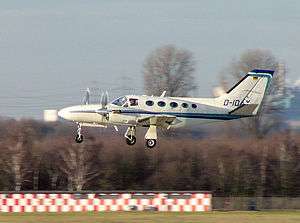Cessna 425
| Model 425 Corsair/Conquest I | |
|---|---|
 | |
| Cessna 425 Conquest I | |
| Role | Utility monoplane |
| National origin | United States |
| Manufacturer | Cessna |
| First flight | September 12, 1978 |
| Produced | November 1980–1986 |
| Number built | 236 |
| Developed from | Cessna 421 |
The Cessna 425, known as the Corsair and later as the Conquest I, is an eight-seat American pressurized turboprop twin-engined light aircraft. Now out of production, it was built by Cessna Aircraft of Wichita, Kansas between 1980 and 1986.
Design and development
The 425 was introduced as a competitor to the Beechcraft King Air. The 425 was introduced in 1980 and was a derivation of the Cessna 421, powered by two 450 hp (336 kW) Pratt & Whitney PT6 engines. In comparison to the King Air C90 "the result was an $875,000 pressurized twin-turboprop that could fly 15 knots to 20 knots faster than the C90, cruise 250 miles farther with four passengers aboard and burn 15-percent less fuel. It also costs $200,000 less to buy".[1][2][3]
The 425 was very easy to fly and was noted by reviewers for its spacious cabin with large windows for good visibility and comfortable seats.[1][2][3]
The original Corsair was developed into the Conquest I by customer demand for more cabin space and a higher maximum takeoff weight. Cessna worked on upgrades that would allow more cabin space and passengers. Essentially, the upgrades increased maximum takeoff weight. The Cessna 441 had previous been called the Conquest, but was renamed the Conquest II. Earlier model Corsairs can be upgraded to Conquest I standard with factory provided modification kits.[1]
Due to economic conditions in general aviation, sales decreased in the mid-1980s and production of the 425 ended in 1986.[1]
Specifications (Cessna 425)

Data from Airliners.net, Airplanepropeller.com and Risingup.com[4][5][6]
General characteristics
- Crew: one pilot
- Capacity: seven passengers
- Length: 35 ft 10 in (10.9 m)
- Wingspan: 44 ft 2 in (13.5 m)
- Height: 12 ft 7 in (3.8 m)
- Wing area: 224.98 ft2 (20.9 m2)
- Empty weight: 4948 lbs (2244.4 kg)
- Max. takeoff weight: 8600 lbs (3719.5 kg)
- Powerplant: 2 × Pratt & Whitney Canada PT6A-112 turboprops, driving Hartzell HC-B3TN-3C propellers, 500 shp (373 kW) each
Performance
- Maximum speed: 264 knots (498 km/h, 309 mph)
- Range: 1339 nm (2480 km, 1540 mi)
- Service ceiling: 33400 ft (10180.32 m)
- Rate of climb: 1862 fpm (9.46 m/s)
See also
- Related development
- Aircraft of comparable role, configuration and era
References
- 1 2 3 4 George, Fred (1 September 2007). "Cessna 425/Conquest i". 101 (3): 192. Retrieved 2012-04-24.
- 1 2 "Cessna 425 Corsair/ Conquest I". The Aviation Consumer: 24–31. September 2009. Retrieved 2012-04-20.
- 1 2 Aarons, Richard (January 1981). "B/CA: Cessna 425 Corsair" (PDF). Business and Commercial Aviation: 1–5. Retrieved 2012-02-20.
- ↑ Cessna Corsair, Conquest I & II & Caravan II retrieved 2009-10-17.
- ↑ Hartzell Props for Cessna Aircraft Archived December 25, 2008, at the Wayback Machine. retrieved 2009-10-17.
- ↑ Cessna 425 Conquest I - Performance Data retrieved 2009-10-17.
External links
![]() Media related to Cessna 425 at Wikimedia Commons
Media related to Cessna 425 at Wikimedia Commons